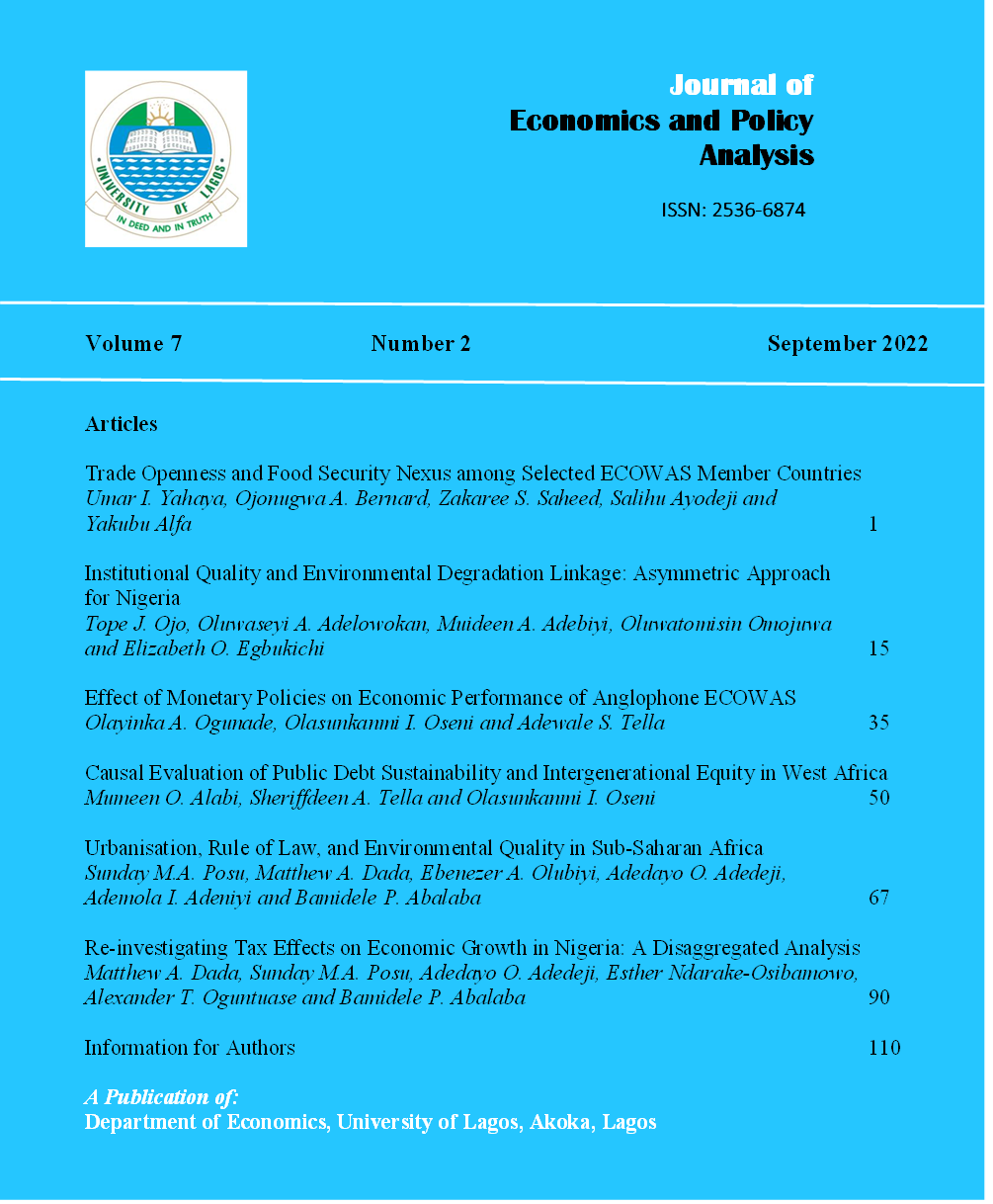Causal Evaluation of Public Debt Sustainability and Intergenerational Equity in West Africa
Abstract
This study investigated the existence of causal relationship between public debt sustainability variables and intergenerational equity West African from 1990 to 2020. The study employed ex-post facto research design using secondary annual panel data obtained from various publications of International Monetary Fund (IMF) and the World Development Indicators (WDI) for the periods 1990-2020. The data were analyzed using Panel Granger Causality techniques. Results from the study revealed a unidirectional causal relationship running from total reserves to tax revenue as well as trade openness to total reserves, no causal relationship between public external debt, exchange rate, tax revenue and foreign reserve and a bidirectional causality between trade openness and public external debt which implies a two-way relation between trade openness and public external debt. Hence fiscal policy authorities in West Africa, particularly the debt management offices (DMOs), should prioritize prudent debt management and adequate reserve accumulation to promote tax smoothing., sufficient reserve accumulation, and careful balance between borrowing and reserve preservation. Striking the right balance would contribute to debt sustainability, currency stability, investor confidence, and long-term economic resilience.
References
Agius, E. (2006). 16 Intergenerational justice (p. 317). Edward Elgar Publishing.
Bamiatzi, V., Efthyvoulou, G., & Jabbour, L. (2017). Foreign vs domestic ownership on debt reduction: An investigation of acquisition targets in Italy and Spain. International Business Review, 26(5), 801–815. https://doi.org/10.1016/j.ibusrev.2017.01.008
Bowen, G. (1994). When a business leader joins a nonprofit board. Harvard Business Review.
Buchanan, J. M. (1950). Federalism and fiscal equity. American Economic Review.
Cuestas, J.C., Gil‐Alana, L.A., & Regis, P.J. (2015). The Sustainability of European External Debt: What have We Learned?. Review of International Economics, 23, 445–468. http://dx.doi.org/10.1111/roie.12175
Davies, R. (2001). Descartes : belief, scepticism and virtue. Routledge studies in seventeenth-century philosophy. https://doi.org/10.4324/9780203420638
Donohoe, M. (2003). Causes and health consequences of environmental degradation and social injustice. Social Science and Medicine, 56(3), 573–587. https://doi.org/10.1016/S0277-9536(02)00055-2
Doi, T., Hoshi, T., & Okimoto, T. (2011). Japanese government debt and sustainability of fiscal policy. NBER Working Paper Series National Bureau of Economic Research Japan,25(4),414-433
Draz, M.U. and F. Ahmad, 2015. External debts and exchange rates of oil-producing and non-oil-producing nations: Evidence from Nigeria
Dritsaki, C. (2013). Causal nexus between economic growth, exports and government debt: The case of Greece. Procedia Economics and Finance, 5(13), 251–259. https://doi.org/10.1016/s2212-5671(13)00031-2
Egbetunde, T. (2012). Public debt and economic growth in Nigeria: Evidence from granger causality. American Journal of Economics, 2(6), 101–106. https://doi.org/10.5923/j.economics.20120206.02
Heise, M. (2019). Inflation targeting and financial stability: Monetary policy challenges for the future. Springer.
Kablamaci, B (2018) Economic growth and public debt in the economic globalization era: an empirical investigation of developing countries. Journal of Social Sciences 3(2) 1-23
Kopf, D. H. (2006). Government debt, intergeneration welfare, and economic activity. The Journal of Finance. https://doi.org/10.2307/2325528
Kouladoum, J. C. (2018). External debts and real exchange rates in developing countries: evidence from Chad.
Lerner, A. P. (1943). Functional finance and the federal debt. Social Research, 10(1), 38–51. https://doi.org/10.2307/40981939
Levin, A., Lin, C. F., & Chu, C. S. J. (2002). Unit root tests in panel data: Asymptotic and finite-sample properties. Journal of Econometrics, 108(1), 1–24. https://doi.org/10.1016/S0304-4076(01)00098-7
Ogunmuyiwa, M. S. (2011). Does fiscal deficit determine the size of external debt in Nigeria?. Journal of Economics and International Finance, 3(10), 580.
Omotor, D. (2021). External debt sustainability in West African countries. Review of Economics and Political Science.
Onakoya, A. B., & Ogunade, A. O (2017) External Debt and Nigerian Economic Growth Connection: Evidence from Autoregressive Distributed Lag Approach. Journal of Economics and Development Studies March 2017, Vol. 5, No. 1, pp. 66-78 ISSN: 2334-2382. Osigwe, A.C., Okechukwu, A.I., Onoja,
T.C. (2015), Modeling the determinant of foreign reserves in Nigeria. International Knowledge Sharing Platform, 5(19), 72-77. Oskarson, A. (2009). Intergenerational equity-Protecting future generations through domestic action.
Owusu-Nantwi, V., & Erickson, C. (2016). Public Debt and Economic Growth in Ghana. African Development Review, 28(1), 116–126. doi:10.1111/1467-8268.12174
Ricardo, D. (1817). Sobre el Comercio Exterior. Principios de Economía Política y Tributación.
Pigou, A. C. (1920). The Economics of welfare. Business Horizons. https://doi.org/10.1016/0007-6813(72)90057-2
Schoder, C., Proaño, C.R., & Semmler, W. (2013). Are the current account imbalances between emu countries sustainable? Evidence from parametric and non‐parametric tests. Journal of Applied Econometrics, 28, 1179–1204. http://dx.doi.org/10.1002/jae.2291
Tella,S.A.(2018) ; The scam elements of external debt. Punch Newspaper.,23 April 2018. https://punchng.com/the-scam-elements-in-external-debt/
Yilanci, V., & Özcan, B. (2007). External debt sustainability of turkey: a nonlinear approach. International Research Journal of Finance and Economics, 20, 91–98.


